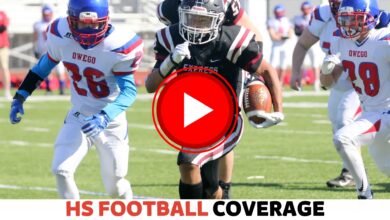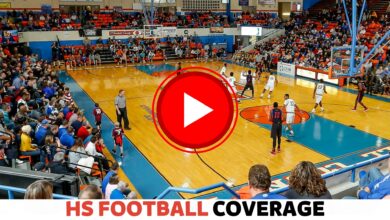What Size Catcher Mitt for High School Baseball: The Ultimate Guide to Find the Perfect Fit

Stream: High School Sports Live On-Demand (Free Trial)
-
High School Basketball -
Live and On-Demand -
Unlimited Access -
Watch on Your Phone, Tab, PC, Smart TV, and Other Devices -
WATCH LIVE HERE
For high school baseball, the recommended size for a catcher mitt is typically a 33-inch mitt. A catcher mitt of this size provides the optimal balance between flexibility and control for a high school catcher.
When selecting a catcher mitt for high school baseball, it’s essential to consider the size that best suits the player’s needs. With a 33-inch mitt, high school catchers can effectively catch and control pitches while still having enough flexibility to handle throws from the field.
This size allows for confident glove-to-glove transfers and quick releases when throwing out baserunners. By choosing the appropriate size catcher mitt, high school catchers can enhance their performance behind the plate and contribute to the team’s overall success.
Understanding the Importance of Proper Sizing
When it comes to high school baseball, having the right equipment is crucial for performance and safety. One piece of equipment that often goes overlooked is the catcher’s mitt.
Choosing the correct size catcher mitt can significantly impact a player’s ability to perform optimally on the field. This article will explore why finding the right size mitt is crucial for high school baseball players.
Why Choosing the Right Size Catcher Mitt is Crucial for High School Baseball Players
When selecting a catcher mitt, it’s essential to consider the player’s hand size, position preferences, and overall comfort. The right size mitt provides several benefits that can directly impact a player’s performance:
- Better Control: A properly sized mitt allows the catcher to have better control over the ball. With a snug fit, the player can secure the ball confidently, reducing the chances of it slipping out or bouncing off the mitt.
- Improved Blocking: Catchers often need to block pitches in the dirt to prevent runners from advancing. An ill-fitting mitt can make it more difficult for a catcher to close the gap between the mitt and the ground, increasing the chances of pitches getting past and runners stealing bases.
- Reduced Hand Fatigue: Wearing a mitt that is too small can cause discomfort and hand fatigue during long games or practice sessions. This can lead to a decrease in performance and potentially increase the risk of injury.
- Proper Finger Alignment: An appropriately sized mitt ensures the catcher’s fingers align correctly within the designated finger stalls. This alignment allows for a more secure grip on the ball and minimizes the risk of finger injury.
The Impact of Using An Ill-fitting Mitt on Performance and Safety
Using an ill-fitting mitt affects a player’s performance and poses safety risks. Here’s why:
- Inadequate Protection: An improperly sized mitt may expose areas of the hand and wrist, leaving them vulnerable to injury from hard pitches or foul tips.
- Suboptimal Performance: With an ill-fitting mitt, catchers may struggle to make accurate throws and tag runners efficiently. This can result in missed opportunities, allowing runners to advance and potentially score.
- Discomfort and Distraction: Wearing a mitt that is too large or small can create pain and distraction, taking the player’s focus away from the game. This can lead to mistakes and missed opportunities.
- Increased Risk of Injury: Catchers are often subjected to high-velocity pitches and powerful swings. An ill-fitting mitt can contribute to hand, wrist, and finger injuries due to inadequate protection and compromised control.
As you can see, the size of a catcher’s mitt plays a significant role in both performance and safety on the baseball diamond. High school baseball players must prioritize finding the right-sized mitt that offers comfort, control, and maximum protection.
Determining the Correct Hand Orientation and Size
Determining the correct hand orientation and size is crucial when finding the perfect catcher mitt for high school baseball. Choosing the right mitt can significantly impact a catcher’s performance and overall comfort on the field.
Under this subheading, we will explore the requirements for left-handed and right-handed catchers and how to measure hand size for the perfect fit.
Left-handed vs Right-handed Catchers and Their Respective Mitt Requirements
Left-handed catchers have different requirements compared to their right-handed counterparts. The primary difference lies in the orientation of the mitt.
The mitt is worn on the right hand for left-handed catchers, known as a “catcher’s mitt.” This mitt is designed to have a deeper pocket and a wider shape than regular infielder or outfielder gloves. The additional padding in the palm area provides extra support when catching high-velocity pitches.
On the other hand, right-handed catchers wear the mitt on their left hand. This mitt is a “catcher’s glove” explicitly designed for right-handed players. It also features a deeper pocket and a broader shape, ensuring the catcher can easily catch fastballs and curveballs.
How to Measure Hand Size for the Perfect Fit
Measuring hand size accurately is essential in ensuring a proper fit for the catcher’s mitt. Follow these steps to measure hand size:
- Use a flexible measuring tape or a piece of string.
- Wrap the tape or string around the catching hand below the knuckles.
- Note the measurement in inches or centimeters.
- Refer to the manufacturer’s sizing guide to find the appropriate mitt size based on hand measurement.
It’s important to note that manufacturers may have slightly different sizing methods, so referring to their specific guidelines will provide the most accurate results.
Getting the correct hand orientation and size for a catcher mitt is essential for high school baseball players. It ensures optimal performance, comfort, and the ability to secure every pitch that comes their way.
Catchers can confidently select a mitt that meets their needs by accurately measuring hand size by understanding the differences between left-handed and right-handed mitts.
Factors to Consider When Choosing a Catcher Mitt
Choosing the right catcher mitt is crucial for any high school baseball player. The catcher’s mitt plays a significant role in their performance, comfort, and overall protection behind the plate.
While there are several factors to consider when selecting the right mitt, the material, padding, webbing, stitching, and wrist closure are vital aspects that can make a difference in a player’s game.
This article will explore these factors and help you decide when selecting the perfect catcher mitt for your needs.
Material: Exploring the Pros and Cons of Leather vs Synthetic Mitts
Choosing between leather and synthetic mitts is one of the first decisions you must make. Each material offers its advantages and disadvantages, which can help you make the right choice.
| Leather Mitts | Synthetic Mitts |
|---|---|
| Pros | Pros |
|
|
| Cons | Cons |
|
|
Padding: The Role of Padding in Comfort and Protection
Padding is another essential factor to consider when choosing a catcher mitt. Adequate padding provides cushioning, ensuring comfort during long practice sessions and games.
It also plays a crucial role in protecting the catcher’s hand from the impact of fastballs and foul tips. Look for mitts with sufficient padding in the palm, thumb, and wrist areas, as these are the most vulnerable to injury.
An additional padded index finger slot can further enhance protection and reduce the risk of injury.
Webbing: Different Types of Webbing and Their Impact on Performance
The type of webbing in a catcher mitt affects its performance and functionality. There are various options to consider:
- Single Post: Provides a larger opening, allowing for better visibility and more effortless ball transfer.
- Modified Trap: Offers a deep pocket for secure catching and enhanced ball control.
- Two-Piece: Combines the advantages of both single post and modified trap, offering a balance between visibility and ball security.
When choosing the webbing style, consider your personal preference and the specific demands of your position.
Stitching: Understanding the Importance of Reinforced Stitching for Durability
Strong and reinforced stitching is crucial for the durability of your catcher mitt. Double or triple stitching in high-stress areas, such as the pocket and webbing, ensures long-lasting performance.
Reinforced stitching prevents the stitches from coming apart when facing the constant impact of fastballs, extending the lifespan of your mitt.
Wrist Closure: The Significance of a Secure Wrist Closure
A catcher mitt with a secure wrist closure is essential for a snug and comfortable fit. It prevents the mitt from moving around during catching and provides stability for quicker glove-to-throw transitions.
Look for mitts with adjustable straps or laces that customize the fit according to your wrist size and preference. A secure wrist closure ensures optimal control and minimizes the risk of injury.
Considering these factors when choosing a catcher mitt will help you find the perfect fit that enhances your performance, provides comfort, and ensures your safety on the field.
Evaluating Specific Features for High School Baseball Catcher Mitts
When choosing the right catcher mitt for high school baseball players, it’s essential to consider specific features that can significantly impact performance.
Deep pocket design, flexibility, cushioning, thumb and finger stalls, and closure options are all crucial elements that deserve careful evaluation.
In this section, we will delve into each of these features, exploring their advantages, disadvantages, and impact on a catcher’s ability to excel in the field.
Deep Pocket: Advantages and Disadvantages of a Deep Pocket Design
A catcher mitt with a deep pocket is popular among high school baseball players. This design offers several advantages that enhance catching ability. A deep pocket provides a larger surface area for the ball to be trapped securely, reducing the chances of it slipping out.
It allows catchers to confidently receive harder throws, giving them a better chance of making crucial plays. Furthermore, a deep pocket design can help retain the ball during tag plays, preventing runners from easily dislodging it.
However, it’s important to note that a deep pocket design may also have drawbacks. Catchers with smaller hands or less strength may find it more challenging to close the mitt fully, especially when receiving low pitches or quick throws.
The deeper pocket can lead to slightly slower ball transfer times when attempting to throw out base runners, potentially diminishing the catcher’s ability to make quick and accurate throws.
Therefore, it’s essential to consider the player’s size, strength, and skill level when deciding on a deep pocket design for their catcher’s mitt.
Flexibility: How a Flexible Mitt Enhances Catching Ability
A catcher mitt’s flexibility is crucial to a player’s ability to catch the ball cleanly. A mitt with proper flexibility allows catchers to adjust their hand position quickly and effortlessly, ensuring they can secure fast pitches or balls thrown slightly off-target.
This flexibility enables catchers to overcome awkward angles and challenging pitch locations that may require them to reach or stretch for the ball.
On the other hand, a catcher mitt that is too rigid can restrict the hand’s natural movement, making it more difficult to react swiftly and adjust to erratic pitches.
Too much stiffness can also lead to discomfort and hand fatigue over long periods of use. Therefore, finding the right balance of flexibility is crucial to enhancing a catcher’s ability to make consistent, secure catches.
Cushioning: The Role of Cushioning in Impact Absorption and Comfort
Cushioning is integral to a high-quality catcher mitt, directly affecting impact absorption and comfort. The padding inside the mitt helps reduce the force of incoming pitches, minimizing the risk of hand injuries or bruises.
Catchers may experience discomfort and pain when repeatedly catching high-speed pitches throughout a game without adequate cushioning.
Similarly, a well-cushioned mitt allows catchers to focus on their technique and performance rather than being distracted by discomfort. Catching long or multiple games in a row becomes more manageable with proper cushioning that supports and reduces hand strain.
When selecting a catcher mitt, it’s essential to ensure that it offers the right level of cushioning to enhance protection and overall comfort.
Thumb and Finger Stalls: Ensuring Proper Fit and Dexterity
The thumb and finger stalls of a catcher mitt greatly determine the fit and dexterity of the glove. Properly fitted stalls are vital to ensure optimal control and grip for catchers.
Catchers can securely grip the ball when the thumb and fingers are snugly positioned, improving their ability to catch and control pitches accurately.
Conversely, if the stalls are too tight or loose, it can hinder a catcher’s ability to maneuver their hand freely, compromising their catching performance.
Ill-fitting stalls can lead to uncomfortable pressure points or slipping fingers, resulting in missed catches and potential errors. Catchers should thoroughly evaluate the thumb and finger stalls when selecting a mitt to achieve the best fit and maximize talent.
Velcro vs Laced Closure: Weighing the Pros and Cons of Different Closure Options
The closure of a catcher mitt is an often overlooked yet critical feature that can impact the overall fit and security of the glove. Two common closure options are velcro and laced closures, each with distinct advantages and disadvantages.
Velcro closures are hassle-free and allow for easy and quick adjustments during a game. They provide a secure fit, eliminating the need for frequent readjustments. However, velcro straps may lose their grip over time and become less effective, requiring replacement.
On the other hand, laced closures offer a traditional and aesthetically pleasing look. They are renowned for their durability and long-lasting performance.
Despite their robustness, laced closures can be more time-consuming to adjust and may require occasional tightening. Catchers who prefer a classic look and don’t mind spending extra time on upkeep may find laced closures more appealing.
Choosing between velcro and laced closures depends on personal preference and the player’s needs. Factors such as ease of use, durability, and aesthetics should be considered when deciding on the closure type for a catcher mitt.
Try It on How to Test the Fit of a Catcher Mitt
When selecting the proper size catcher mitt for high school baseball, one crucial step is to try it on and test the fit. Proper fit ensures optimal performance on the field and helps reduce the risk of injuries.
To assist you in this process, here are some essential tips to consider when trying on a catcher mitt:
Tips for Properly Trying on a Catcher Mitt
Checking the fit of a catcher mitt isn’t just about the overall size; it also involves various other factors. Some tips to consider when trying on a catcher mitt are:
- Start by loosening the wrist strap before putting your hand into the mitt. This allows for easier access and helps prevent unnecessary strain on the strap.
- Place your hand into the mitt, ensuring your palm fits snugly in the pocket. The mitt should neither be too tight nor too loose. A proper fit allows for a secure grip on the ball, ensuring you don’t drop any potential strikes.
Checking for Proper Finger Alignment and Maneuverability
Check for proper finger alignment and maneuverability once you have the mitt on your hand. Here’s how:
- Ensure your fingers align with the finger holes of the mitt. Each finger should comfortably rest in its hole, promoting stability and control when catching and throwing.
- Gently move your fingers to test maneuverability. They should have enough freedom to flex and extend without feeling restricted. This flexibility is vital for quick and accurate movements while catching and throwing.
Testing Comfort and Range of Motion
Comfort and range of motion are essential aspects of a well-fitting catcher mitt. Be sure to consider the following:
- Secure the mitt correctly with the wrist strap. It should be snug but not overly tight, allowing for comfortable movement without the risk of the mitt slipping off during intense gameplay.
- Bend and flex your hand, testing the range of motion that the mitt allows. You should be able to close your hand comfortably, forming a stable grip on the ball. Avoid any discomfort or limitations that hinder your ability to catch and throw effectively.
By following these tips and adequately testing the fit of a catcher mitt, you can ensure that you have the correct size and style for your needs. Remember, a properly fitted mitt enhances your performance and protects you from potential injuries.
Conclusion
To determine the correct size catcher mitt for high school baseball, consider the player’s age, skill level, and position. An adequately fitted mitt enhances performance by providing optimal control and comfort. It is crucial to consult with coaches and players to ensure the proper selection.
By doing so, athletes can maximize their potential, maintain stability behind the plate, and ultimately make their mark in the game. Finding the right catcher mitt is a game-changer, so choose wisely and let your skills shine on the field.





